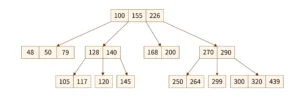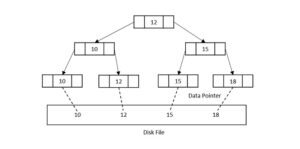B-Trees and B+ Trees
As databases grow in size, efficient search and retrieval become critical. Traditional indexing techniques like binary search may not be fast enough due to disk access limitations. That’s why tree-based indexing structures like B-Trees and B+ Trees are widely used in database systems for balanced, multi-level indexing.
B-Trees
A B-Tree is a self-balancing search tree used to maintain sorted data and allow searches, sequential access, insertions, and deletions in logarithmic time.

Key Properties:
- All leaves appear at the same level (i.e., balanced).
- Every node (except the root) has at least ⌈m/2⌉ children if the order is
m. - Internal nodes store both keys and pointers to child nodes.
- Keys in a node are sorted, and the tree allows for quick traversal to find the correct path.
Why Use B-Trees?
- Designed to minimize disk reads by having a high branching factor (more children per node).
- Works well when data is too large to fit in memory.
Operations:
- Search: Begins at the root, follows the path according to key comparisons.
- Insert/Delete: Ensures balance by splitting or merging nodes when necessary.
B+ Trees
A B+ Tree is a refinement of B-Tree, specially optimized for range queries and disk storage.

Key Differences from B-Trees:
- All data records are stored only at the leaf level.
- Internal nodes store only keys (not data), serving purely as routing indexes.
- Leaf nodes are linked using pointers, forming a linked list.
Key Properties:
- Efficient sequential access due to leaf-level linked list.
- Reduces tree height, so search and range queries are faster.
- Better suited for disk-based storage systems, where reading entire blocks is expensive.
Comparison Table
| Feature | B-Tree | B+ Tree |
|---|---|---|
| Data Location | Internal & Leaf Nodes | Only in Leaf Nodes |
| Internal Nodes | Keys + Data pointers | Keys only (no actual data) |
| Leaf Node Structure | Unlinked | Linked (for range traversal) |
| Range Query Efficiency | Moderate | High (via linked leaf nodes) |
| Space Utilization | Slightly lower | Higher due to denser leaves |
| Use Case | General indexing | Preferred in DBMS & file systems |
When to Use Which?
B-Trees: When both point lookups and small-size storage are priorities.
B+ Trees: When range queries are common, and storage is large and disk-based. Most modern databases use B+ Trees for indexing due to their superior performance and efficiency in such environments.